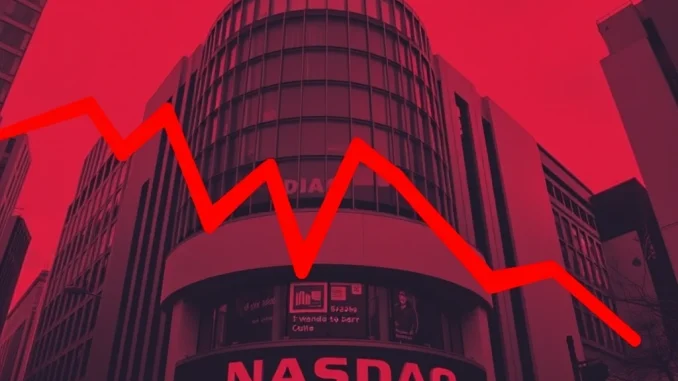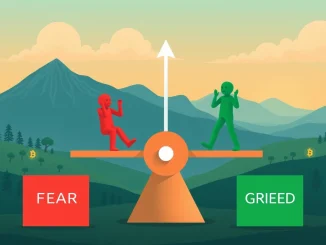
Buckle up, traders! The markets are flashing red as Nasdaq futures are experiencing a significant downturn. Are you prepared for the potential ripple effects across the financial landscape? Today, we’re diving deep into the alarming slide of Nasdaq futures and what this could signal for your trading strategies. Stay with us as we unpack the details of this market event.
Nasdaq Futures Plunge: Decoding the Stock Market Crash
The financial world is currently witnessing a concerning trend as Nasdaq futures, specifically the NQ1! contract, are experiencing a sharp decline. According to real-time data from TradingView, the NQ1! contract has plummeted by a staggering 3.63%, currently trading at 17,982.00. This significant drop raises immediate questions and concerns among investors and market analysts alike. Let’s break down what’s happening:
- Sharp Decline: A 3.63% drop in Nasdaq futures is not just a minor fluctuation; it’s a substantial stock market crash signal indicating strong selling pressure.
- NQ1! Contract in Focus: The NQ1! contract is a key indicator of the Nasdaq 100 index’s future performance, making this downturn particularly noteworthy for tech-heavy stock enthusiasts.
- TradingView Data: Reputable sources like TradingView confirm the severity of this market downturn, lending credibility to the widespread concern.
- Below 18,000 Level: Trading below the 18,000 mark is a psychologically significant level, potentially triggering further sell-offs and increased volatility.

Nasdaq Futures NQ1! Contract Chart Showing Sharp Decline
What Factors are Fueling this Market Downturn?
Several factors could be contributing to this unsettling market downturn. While the exact reasons can be multifaceted and complex, some common triggers for such significant drops in Nasdaq futures often include:
- Inflation Concerns: Persistent inflation worries can lead to expectations of tighter monetary policy, impacting growth stocks that are heavily represented in the Nasdaq.
- Interest Rate Hikes: Anticipation or actual increases in interest rates can make borrowing more expensive, dampening corporate earnings outlooks and investor sentiment.
- Geopolitical Instability: Global events and geopolitical tensions can introduce uncertainty, prompting investors to reduce risk and sell off assets.
- Earnings Season Jitters: As earnings season approaches or unfolds, disappointing results or lowered guidance from major tech companies can trigger widespread selling.
- Profit Taking: After periods of sustained gains, investors may engage in profit-taking, leading to temporary but sharp pullbacks.
Impact of Trading Losses on Investors and Traders
The immediate impact of this trading losses scenario is felt most acutely by traders holding positions in Nasdaq futures or related assets. Here’s a look at the potential consequences:
| Impact Area | Description |
|---|---|
| Margin Calls | Traders using leverage may face margin calls if their positions decline significantly, requiring them to deposit more funds to cover potential losses. |
| Portfolio Erosion | Investors with significant exposure to Nasdaq-related assets will see a direct decrease in their portfolio value. |
| Increased Volatility | Sharp declines often lead to heightened market volatility, making trading riskier and potentially leading to further price swings. |
| Psychological Impact | Significant losses can create emotional stress and panic selling, exacerbating the stock market crash. |
NQ1 Futures: Why is this Contract Important?
The NQ1 Futures contract is not just another ticker symbol; it’s a crucial barometer for the tech sector and the broader market. Here’s why it commands so much attention:
- Nasdaq 100 Proxy: NQ1! futures directly reflect the anticipated performance of the Nasdaq 100 index, which is heavily weighted towards technology and growth stocks.
- Leading Indicator: Futures markets often react to news and sentiment faster than the cash market, making NQ1! a leading indicator for potential movements in the Nasdaq 100.
- Liquidity and Volume: The NQ1! contract is highly liquid and actively traded, providing robust price discovery and making it a reliable gauge of market sentiment.
- Global Impact: Movements in Nasdaq futures can have ripple effects across global markets, influencing investor sentiment and trading activity worldwide.
Navigating the Market Downturn: Actionable Insights
In times of stock market crash and increased volatility, strategic actions are crucial to protect your investments and potentially capitalize on opportunities. Consider these actionable insights:
- Review Your Portfolio: Assess your exposure to Nasdaq-related assets and consider rebalancing if necessary to manage risk.
- Risk Management: Implement or reinforce risk management strategies, such as setting stop-loss orders to limit potential losses.
- Stay Informed: Keep abreast of market news and economic developments that could further impact market movements.
- Consider Diversification: Diversifying your portfolio across different asset classes can help cushion the impact of downturns in specific sectors.
- Seek Professional Advice: Consult with a financial advisor to tailor a strategy that aligns with your risk tolerance and investment goals.
Conclusion: Staying Vigilant in a Volatile Market
The sharp slide in Nasdaq futures serves as a stark reminder of the inherent volatility of financial markets. Understanding the factors driving this market downturn and taking proactive steps are essential for navigating these turbulent times. While trading losses can be concerning, informed and strategic approaches can help investors weather the storm and position themselves for future opportunities. Stay vigilant, stay informed, and trade wisely as the market continues to unfold.



